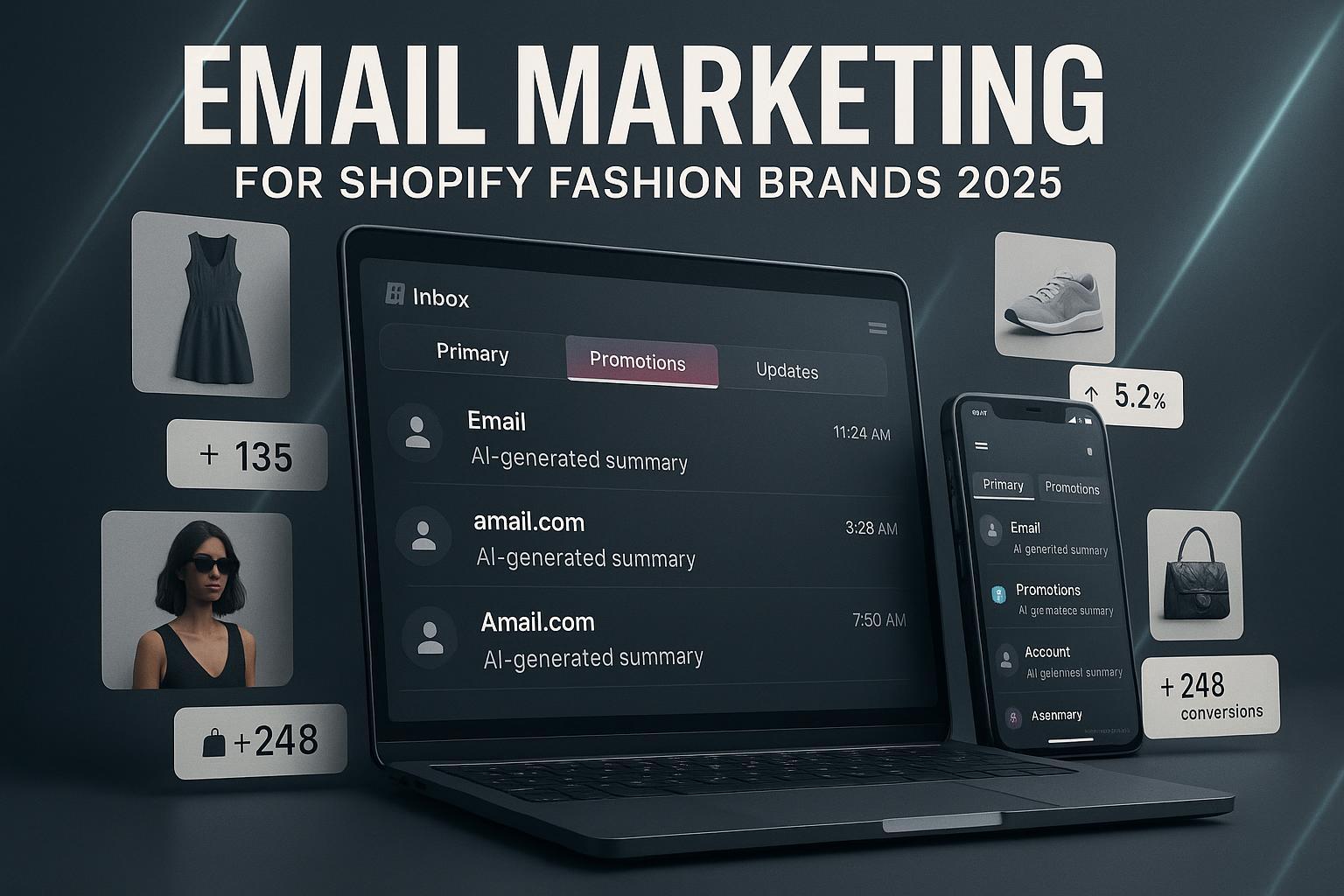Email Marketing Trends for Shopify Fashion Brands in 2025

Fashion inboxes are noisier than ever—and 2025 changed the rules again. Between stricter bulk-sender enforcement, Apple’s iOS 18 Mail behaviors, and shifting KPIs beyond opens, Shopify fashion brands need a playbook that balances compliance, creative, and measurement. Here’s what’s truly new this year and how to turn it into revenue without burning your list.
1) Deliverability got real: 2025 enforcement you can’t ignore
If you email consumers at scale, the compliance floor rose in 2025.
- Microsoft began enforcing SPF, DKIM, and DMARC for senders delivering roughly 5,000+ messages/day to Outlook/Hotmail/Live on May 5, 2025. While the initial guidance suggested junking, later clarifications indicate non‑compliant traffic is rejected outright with SMTP 550 5.7.15. See Microsoft’s own note in the Microsoft TechCommunity announcement (Apr 2025) and the follow‑up perspective from Validity’s 2025 explainer on Microsoft rejections.
- Gmail and Yahoo’s 2024 standards carried into 2025. For bulk senders, DMARC with alignment to the From: domain, one‑click list‑unsubscribe, and low complaint rates remain table stakes. Google summarizes expectations in the Gmail Sender Guidelines (official, 2025).
Practical authentication checklist for Shopify brands:
- Publish and align: SPF pass, DKIM pass, DMARC published (policy p=none or stronger) aligned to your From: domain
- Hygiene and consent: keep spam complaints well under 0.3% (aim <0.1%); remove hard bounces/complainers quickly
- One‑click List‑Unsubscribe header plus a visible footer link; process removals fast
- Technical basics: valid PTR/rDNS, TLS, consistent branded From/Reply‑To, no deceptive subjects
- Monitor reputation: Google Postmaster, Microsoft SNDS equivalents; track spikes during promotions and drops
Why it matters to fashion: Launch calendars and frequent promos make apparel lists vulnerable to complaints and fatigue. Tighten your suppression rules around high‑pressure moments (BFCM, limited drops) and give VIPs slower cadence options.
2) Winning the iOS 18 Mail inbox: categories, AI previews, and brand trust
iOS 18 reshaped how many shoppers see your messages.
- Apple’s Mail Privacy Protection still obfuscates opens via proxy preloads, so opens remain an unreliable metric. Twilio SendGrid’s 2025 overview of MPP reiterates why click‑centric measurement is safer; see Twilio SendGrid’s Apple MPP insights (2025).
- Mail categories/tabs (Primary, Transactions, Updates, Promotions) and AI‑generated previews are changing attention patterns. Listrak’s May 2025 analysis summarizes early findings and creative implications; see Listrak’s iOS 18 Mail recommendations (May 2025).
Creative tactics that work for fashion:
- Category‑aware subject lines: Signal “Order Update,” “Shipping,” or “New Drop” clearly so Apple’s categories and users file you correctly.
- Front‑load value: The first 1–2 lines should carry the core offer or story; AI summaries may surface this instead of your preheader.
- Branded identity: Keep a consistent, trustworthy From name. If you implement brand‑verified display (e.g., BIMI/Apple Branded Mail where applicable), it can reinforce authenticity.
- Digest‑friendly design: Modular content blocks help your “Updates” or “Promotions” snippets communicate even when bundled.
3) KPIs that actually move revenue in 2025 (with fashion benchmarks)
Opens are noisy; fashion teams are rebuilding their scorecards around clicks, conversions, and revenue per email.
- Fashion and apparel send patterns in 2025 are shifting. A Q2 2025 dataset from TargetBay covering ~99,800 emails across 2,800+ fashion brands highlights popular send windows (3–6 PM, 6–9 PM) and subject trends moving beyond pure discounts. Review the context and caveats in TargetBay’s Fashion & Apparel Q2 2025 analysis.
- Email ROI remains resilient for ecommerce, but the leaders emphasize CTOR, conversion rate, and revenue per email rather than opens. Treat opens as directional only for non‑Apple audiences.
Test plan ideas for fashion brands:
- CTOR and revenue per email: Iterate on hero creative (UGC lookbook vs. editorial product grids), offer framing (bundle vs. single SKU), and price anchoring.
- Send‑time splits by cohort: VIPs and high‑intent waitlists might respond best earlier in day; casual browsers later. Validate with short, controlled tests.
- Segmentation by style/fit: Use zero‑party data (size, fit, style preferences) to limit irrelevant promos and reduce complaints.
- Post‑purchase depth: Returns and care content lower churn and can increase accessory attach rates.
4) Practical workflow: attribute email’s real revenue across channels
Most Shopify fashion teams run email alongside SMS and paid social. To understand true impact, you need multi‑touch attribution across journeys—not last‑click only.
Here’s a repeatable workflow:
- Define the flow: For example, a “New Season Lookbook” email sequence with a supporting Instagram ad set and an SMS reminder.
- Instrument the touchpoints: Ensure UTMs and consistent campaign naming; pass identifiers from Shopify to your ESP and analytics.
- Resolve identities: Tie anonymous sessions to known shoppers post‑click or via quiz/sign‑ups.
- Model incremental revenue: Compare exposed vs. holdout cohorts where possible; report revenue per recipient and cohort ROAS.
Tooling example: With Attribuly, you can align Shopify orders, paid clicks, and email touches to evaluate multi‑touch impact, then push segments back into your ESP for next‑step targeting. Disclosure: Attribuly is our product.
- To quantify ROAS across email + ads, connect your attribution workspace to your ESP. See how to Measure Every Campaign ROAS and set up the Klaviyo Integration so flows and campaigns sync with consistent IDs.
- Reporting tip: For “drop” campaigns, compare cohorts who got email+SMS vs. SMS‑only to isolate email’s lift on conversion and AOV.
5) Shopify ecosystem update: a small but mighty win for list quality
Shopify now lets customers update their account email addresses themselves (with a secure OTP flow) if you use new customer accounts. This reduces manual fixes and keeps your list clean. See the official note in the Shopify Changelog (Oct 8, 2025).
What to do next:
- Promote account sign‑in across transactional emails and post‑purchase pages so customers keep their contact info current.
- Use verified account data to reconcile duplicates before peak season.
6) Orchestrating drops and BFCM without frying your list
Fashion calendars are spiky. To stay compliant and effective:
- Channel roles by moment: Use SMS for time‑sensitive alerts (queue openings, last‑chance windows) and email for story, imagery, and merchandising depth.
- Cadence and suppression: During high‑pressure weeks, suppress recent complainers and low‑engagement segments. Offer a “fewer emails this week” opt‑down.
- Waitlists and reservations: Build zero‑party data via fit/style waitlists. Prioritize top cohorts for early access and throttle the rest to protect complaint rates.
- Creative stamina: Rotate modules—UGC try‑ons, editorials, and utility content (care/returns) to balance promos.
7) Your Q4 2025 action checklist
- Verify SPF, DKIM, DMARC (aligned), List‑Unsubscribe, PTR/rDNS; confirm complaint rates <0.3%
- Review Gmail/Yahoo/Microsoft sender health weekly during peak; fix bounces/complaints fast
- Design for iOS 18: category‑aware subjects, value‑first first lines, consistent branded sender identity
- Shift KPIs to CTOR, conversion, and revenue per email; use cohort ROAS for campaigns with paid assists
- Stand up a multi‑touch attribution view across email, SMS, and ads; validate lift with holdouts when feasible
- Clean your list and enable Shopify’s self‑serve email updates to reduce data friction
Why this matters now
The compliance step‑up from Microsoft—and the behavior shifts from iOS 18—arrived just as fashion’s busiest months hit. Brands that align authentication, rethink creative for categorized inboxes, and measure impact beyond opens will keep winning share while competitors fight deliverability fires.
Next steps
- Run a 30‑minute audit: auth records, unsubscribe headers, complaint rates, and iOS 18–friendly templates.
- Implement a basic multi‑touch dashboard for email+SMS+ads; plan one lift test before holiday cutoffs.
- If you need a faster path to attribution and identity resolution across Shopify, email, and paid, consider Attribuly for a focused pilot with your Klaviyo flows.
References and further reading
- Microsoft enforcement for high‑volume senders (Apr–May 2025): Microsoft’s announcement and Validity’s clarification on rejections
- Gmail expectations for bulk senders: Gmail Sender Guidelines (official)
- Apple privacy context: Twilio SendGrid on Apple MPP (2025)
- iOS 18 Mail behaviors and creative implications: Listrak iOS 18 findings (May 2025)
- Shopify platform update: Shopify Changelog — customer email self‑update (Oct 8, 2025)
- Fashion sending patterns and subject trends: TargetBay Fashion & Apparel Q2 2025
